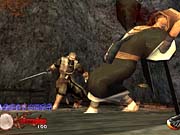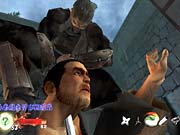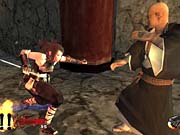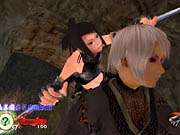Tenchu: Wrath of Heaven Preview
The stealth assassins are back. Get caught up on all the details of this ninja-ridden action game by reading our preview.
From the very moment you begin playing the latest Tenchu game, it becomes clear that the development team at K2 set out to correct many of the problems in the previous installment in the stealth action series. Indeed, the range of changes is vast and includes everything from the smallest refinements to the camera system to a vastly improved control scheme that resembles those found in the Metal Gear Solid and Devil May Cry. But perhaps the biggest change that Tenchu: Wrath of Heaven makes to the series is the addition of a two-player split-screen cooperative mode in which you and another ninja can stalk through an enemy palace and perform dual stealth kills on unsuspecting guards.

Fans of the series will likely also be excited about the reappearance of the first game's hero, Rikimaru, who was seemingly killed at the end of the original Tenchu adventure. Upon selecting the stoic ninja at the character select screen, you'll see him emerge from the cave where he supposedly died, charge through a serene forest setting toward a massive waterfall, and then leap off headfirst to begin his first mission. It's a dramatic way for Rikkimaru to make his return, but one that K2 feels is very important for easing you into the game, since this particular opening level is devoid of any foes.
Before each mission actually starts, the ninja you select--whether it's Rikimaru or his female counterpart, Ayame--has an opportunity to select from a stockpile of items, ranging from sticky bombs to fireworks. Since ninjas aren't known to take pack mules on their adventures, you can carry only a certain number of items, which can make the selection process a little more difficult, but as you progress through the game, you'll undoubtedly find that some items are more useful than others. For example, when fired off into the sky, the fireworks item will briefly distract guards, allowing you to sneak in for the kill. The poison rice balls serve a similar purpose, distracting and then dispatching guards who are suffering from hunger pains. Other items can be a little more deadly, like the sticky bomb, which will immediately latch onto any object or enemy it makes contact with. Unfortunately, we didn't get to see all the items in action, but judging from the ones that were on display, it's quite clear that learning the tricks behind each item will be crucial, particularly in the later levels of the game, when enemies become more difficult to deal with.

In addition to items that serve the specific purpose of distracting enemies, you'll have access to items that will help you get out of tight situations and make it safely through the levels. One such item is the grappling hook, which allows you to target an area within the environment and pull yourself up to it. Clearly, the grappling hook is quite useful when being swarmed by enemies, but it's helpful whenever it appears that you've reached a dead end. It's also worth noting that you can pick up enemies' weapons after you've defeated them.
Playing Possum
Of course, you won't always have to rely on hardware to avoid enemies or set up an ambush, as both Rikimaru and Ayame have special magic skills. If you want to take a slightly less stealthy approach, Rikimaru can don a disguise that will allow him to walk right past a guard without arousing suspicion. But perhaps his most interesting of all is his ability to seemingly commit suicide with his blade and then to fall to the ground and lie motionless. Guards will come over to inspect the body, giving you an opportunity to launch a surprise attack.

In most situations, the best course of action is to go for a stealth kill, but in boss battles, it seems that you'll always have to take the enemy head on. One boss battle we saw pitted Rikimaru against an enemy equipped with a pistol, and not only could this particular enemy attack Rikimaru from long range, but he also had some nasty close-quarters moves as well, such as his ability to throw Rikkimaru into the air and then shoot him multiple times in the gut. You'll take quite a bit of punishment initially, but you'll gain the advantage as soon as you identify the boss' patterns and weaknesses. This sort of identification is one of the many elements that give Tenchu: Wrath of Heaven a strong strategic feel, and even with the normal enemy characters, you'll start to learn how each one reacts differently--enemies will base their attacks around the type of weapon they're equipped with--and adjust accordingly.

In fact, strategy becomes even more important in the two-player split-screen cooperative mode. In one of the levels we saw, the game is automatically over if either player is detected, so you and the other player have to coordinate your attacks so that neither one of you is seen. It may sound simple, but it can actually be quite difficult, since you've essentially doubled your chance of being spotted by an enemy guard. If anything, this particular mode will give you a greater appreciation for the improvements made to the camera, which now gives you a much more useful look at immediate area when your back is up against a wall. In addition, you'll also get a good look at the visual improvements K2 has in store for Tenchu: Wrath of Heaven when you see the silky smooth animation on the dual stealth skills.
All the multiplayer levels--including the new deathmatch mode--have been somewhat downgraded in visual quality so the development team could maintain a brisk frame rate. But the single-player levels look quite good at this point, with plenty of detail in the surrounding scenery and some nice special effects, such as the MGS2-style rain effect showcased in the Tokyo Game Show demo. There's still plenty more to be revealed about Tenchu: Wrath of Heaven, and we'll continue to follow the game's progress until its release in spring 2003.
Got a news tip or want to contact us directly? Email news@gamespot.com
Join the conversation